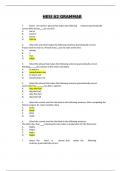Summary
Samenvatting Business Fundamentals
- Module
- Institution
- begrijpt de complexiteit en de dynamiek van de bedrijfsvoering. - definieert en beschrijft de negen basisbouwstenen van het Busines Model Canvas voor het product/de dienst van de onderneming/organisatie. - gebruikt het Business Model Canvas om de complexiteit en de dynamiek van de bedrijfsvoeri...
[Show more]











